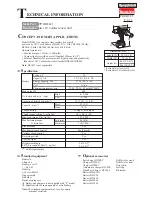
6 ENGLISH
ASSEMBLY
CAUTION:
Always be sure that the tool is
switched off and unplugged before carrying out
any work on the tool.
Installing side grip (auxiliary handle)
►
Fig.4:
1.
Grip base
2.
Side grip (auxiliary handle)
3.
Teeth
4.
Protrusion
Always use the side grip to ensure operating safety.
Install the side grip so that the teeth on the grip fit in
between the protrusions on the tool barrel. Then tighten
the grip by turning clockwise at the desired position.
NOTE:
The depth gauge cannot be used at the posi
-
tion where the depth gauge strikes against the tool
body.
Installing or removing drill bit
CAUTION:
Always be sure that the tool is
switched off and unplugged before installing or
removing the drill bit.
For model DP4010
►
Fig.5:
1.
Chuck key
To install the drill bit, place it in the drill chuck as far as
it will go. Tighten the chuck by hand. Place the chuck
key in each of the three holes and tighten clockwise. Be
sure to tighten all three chuck holes evenly.
To remove the drill bit, turn the drill chuck key counter
-
clockwise in just one hole, then loosen the chuck by
hand.
After using the chuck key, be sure to return it to the
original position.
For model DP4011
►
Fig.6:
1.
Sleeve
2.
Ring
Hold the ring and turn the sleeve counterclockwise to
open the chuck jaws. Place the drill bit in the drill chuck
as far as it will go. Hold the ring firmly and turn the
sleeve clockwise to tighten the chuck.
To remove the drill bit, hold the ring and turn the sleeve
counterclockwise.
Depth gauge
Optional accessory
The depth gauge is convenient for drilling holes of
uniform depth. Loosen the side grip and insert the depth
gauge into the hole on the side grip. Adjust the depth
gauge to the desired depth and tighten the side grip
firmly.
►
Fig.7:
1.
Depth gauge
NOTE:
The depth gauge cannot be used at the posi
-
tion where the depth gauge strikes against the tool
body.
OPERATION
Holding tool
►
Fig.8
Always use the side grip (auxiliary handle) and firmly
hold the tool by side grip and switch handle during
operations.
Drilling operation
Drilling in wood
When drilling in wood, the best results are obtained
with wood drills equipped with a guide screw. The guide
screw makes drilling easier by pulling the drill bit into
the workpiece.
Drilling in metal
To prevent the drill bit from slipping when starting a
hole, make an indentation with a center-punch and
hammer at the point to be drilled. Place the point of the
drill bit in the indentation and start drilling.
Use a cutting lubricant when drilling metals. The excep
-
tions are iron and brass which should be drilled dry.
CAUTION:
Pressing excessively on the tool
will not speed up the drilling.
In fact, this excessive
pressure will only serve to damage the tip of your drill
bit, decrease the tool performance and shorten the
service life of the tool.
CAUTION:
Hold the tool firmly and exert care
when the drill bit begins to break through the
workpiece.
There is a tremendous force exerted on
the tool/drill bit at the time of hole break through.
CAUTION:
A stuck drill bit can be removed
simply by setting the reversing switch to reverse
rotation in order to back out. However, the tool
may back out abruptly if you do not hold it firmly.
CAUTION:
Always secure workpieces in a
vise or similar hold-down device.
CAUTION:
Avoid drilling in material that you
suspect contains hidden nails or other things that
may cause the drill bit to bind or break.
Summary of Contents for 0088381093804
Page 2: ...1 3 5 2 4 Fig 1 A B 1 Fig 2 1 2 Fig 3 1 2 3 4 Fig 4 1 Fig 5 1 2 Fig 6 1 Fig 7 Fig 8 2 ...
Page 3: ...1 Fig 9 3 ...
Page 50: ...50 ...
Page 51: ...51 ...







































